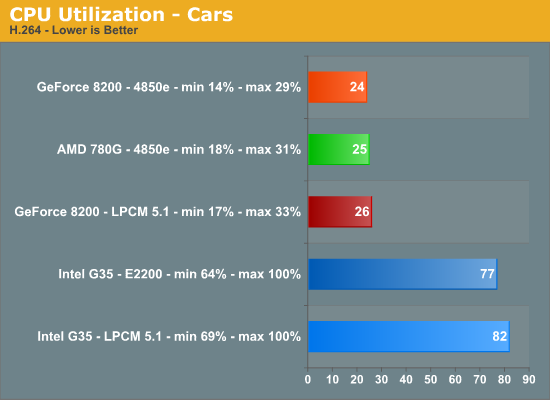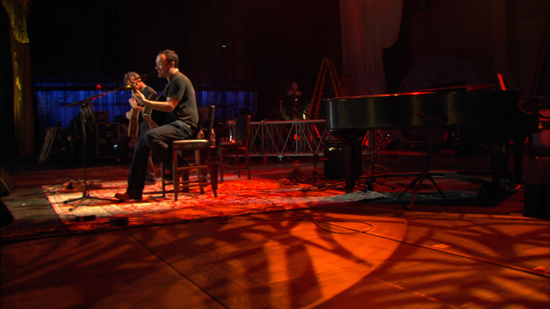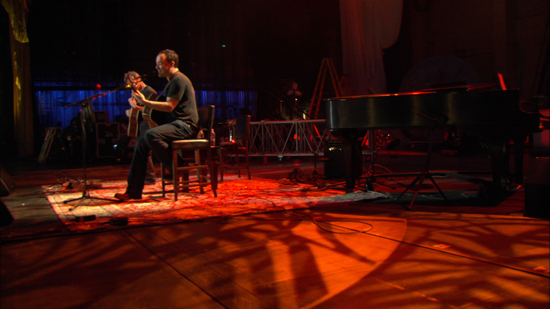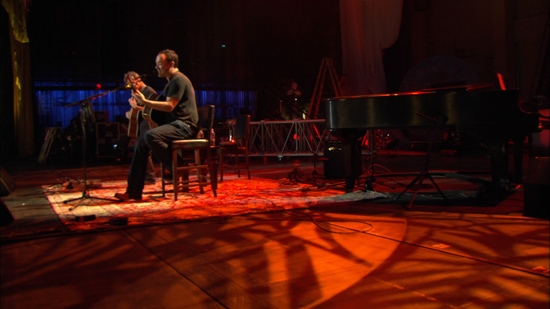AMD 780G: Preview of the Best Current IGP Solution
by Gary Key on March 10, 2008 12:00 PM EST- Posted in
- CPUs
H.264 Video Quality - Cars
One of our favorite movies last year was Cars from Disney / PIXAR. It may be a kid-oriented movie but who can resist fast cars and a love story to boot. This movie offers bitrate levels that average 14.1 Mb/s to 31.9 Mb/s. In our particular test scene, the Hudson Hornet is in the pit lanes acting as crew chief. This image provides an array of colors and contrast opportunities for dissection.
 780G – Click to Enlarge |
 G35 – Click to Enlarge |
 GeForce 8200 – Click to Enlarge |
The differences in the images are small but the GeForce 8200 appears to have slightly deeper colors along with a very slight edge in sharpness that we will discuss shortly. The reference image was in between the G35 and 780G, but even that decision was a tossup in our opinion. However, our test audience voted differently than the reference image with 4 votes in favor of the GeForce 8200, 3 for the G35, and 1 for the 780G.
This is one title that benefits from NVIDIA's new HD Dynamic Contrast and Color enhancements that will vary contrast ratios on the fly while enforcing a slightly stronger color palette across the image. We find this technology is well suited to animated titles but our opinions differ strongly when it comes to natural images. Almost all of us did not like the contrast enhancement technology but several thought the color enhancement feature offered a better overall picture in most cases.

Even though the G35 platform had an excellent image, there is no comparison in the CPU utilization rates during playback compared to the hardware accelerated decoding offered by NVIDIA and AMD. As expected, the 780G kills the G35 with average utilization rates at 25% compared to 77%. Of course, the G35 does not offer hardware acceleration for decoding H.264 (AVC) content and as such suffers from severe judder at times once the CPU utilizations rates go above 95.
In early Phenom testing with the 8.3 release drivers we noticed CPU utilization rates dropping several percent while image quality improved due to the post-processing capabilities on the HD 3200 when paired with an HT 3.0 capable CPU. We will have those results shortly.
VC1 Video Quality - Dave Matthews and Tim Reynolds
We are constantly playing our “Live at Radio City” Blu-ray disc featuring Dave Matthews and Time Reynolds from ATO/RCA/BMG record labels in the labs. It is one of our reference discs for audio quality and besides we just enjoy the music. This disc offers bitrate levels that averaged 13.06 Mb/s to 31.3 Mb/s. In our particular test scene, we see Dave and Tim performing from the right side of the stage. This image provides an array of colors, shadows, and various lighting angles for review.
 780G – Click to Enlarge |
 G35 – Click to Enlarge |
 GeForce 8200 – Click to Enlarge |
The differences in the images are minor but the 780G appears to offer slightly better detail and background image in our estimation. This time, the GeForce 8200 image was faithful to the reference image during playback tests. . Our test audience voted 3 in favor of the GeForce 8200, 3 for the 780G, and 2 for the G35.
This was one test where the opinions differed greatly after watching several minutes of the video. The majority thought the GeForce 8200 offered more “pleasant” tones and brightness control while several thought the 780G provided greater image depth and balanced colors (especially close-ups) that the G35/GeForce 8200 could not.

The 780G and GeForce 8200 offer CPU utilization rates several percent lower in this title than the G35. When using PowerDVD to decode the Dolby TrueHD 5.1 audio stream, we noticed our average processor utilization rate increased about 5%~9% on average.










49 Comments
View All Comments
greenfuzion - Thursday, April 17, 2008 - link
http://www.youtube.com/watch?v=_l2e0mf3CcA">http://www.youtube.com/watch?v=_l2e0mf3CcASchugy - Tuesday, March 11, 2008 - link
The new AMD chipset is a good choice for a MythTV frontend and it will play normal mpeg2 tv flawlessly.But I won't need any HD capabilities because video players like kaffeine or mplayer won't support HDCP crap or any hardware accelleration.
With the lousy closed source nVIDIA linux driver not supporting pureview I can't even watch the unencrypted EA Burnout Paradise demo video fullscreen (VIDEO: [avc1] 1280x720 24bpp) without any performance problems. But I think a Sempron 3000+ SOA and a 7600GT should be enough for this resolution far away from full HD.
I won't spend any money for HD hardware or HD content because there's no sense in it.
najames - Tuesday, March 11, 2008 - link
Since these boards are intended as media PCs, I think you should be doing thorough testing of the onboard LAN. My Biostar TA690G does a decent job on gigabit, my Gigabyte GA-MA69GM-S2H sucked at sending, ok in receiving. Intel Pro1000 PCI-e x1 replacement card did a lot better on the Gigabyte, although I still question the boards throughput. I have done a LOT of LAN testing on Linux for a building server. This kind of stuff needs to be checked, writing to a single WD 640GB drive.ftp> put mint.iso
local: mint.iso remote: mint.iso
200 PORT command successful. Consider using PASV.
150 Ok to send data.
226 File receive OK.
722104320 bytes sent in 6.41 secs (109965.8 kB/s)
ftp> quit
yehuda - Wednesday, March 12, 2008 - link
Gigabyte's 690G and 690V boards suck at network performance because they use a PCI controller as upposed to a PCI Express controller in most other boards.Fortunately, the GA-MA78GM-S2H is free from this drawback. You can check the network results here:
http://www.techreport.com/articles.x/14261/13">http://www.techreport.com/articles.x/14261/13
That said, I can't explain your comment on questionable throughput with the replacement PCI-e card.
rhofmann - Tuesday, March 11, 2008 - link
1080p HD decode is great, but in my experience I've found that the de-interlacing required by 1080i broadcast HD content has been an Achilles heel for HTPC output with integrated graphics.jamawass - Tuesday, March 11, 2008 - link
Never thought I'd see the day when Tomshardware actually published a better review than Anandtech. I don't understand how a review article on AMD 780g ends with a paragraph on an Intel chipset talking about strengths in"office applications", heck a igp chipset 10 yrs ago was good in office applications.This is the best IGP chipset currently and the article should have stated that categorically instead of using lame " AMD got it almost right". What use is lpcm audio when the image is paused and juddering on your screen?
Power consumption, sound use are all relevant when reviewing a platform like this I just didn't see the empahsis on these in this article.
TheJian - Tuesday, March 11, 2008 - link
I was surprised by TomsHardware too. I haven't put much stock in their site for years (since a ways before they soldout). In the beginning Tom Pabst did an excellent job HIMSELF. But now it's just his name on the site. I expected to read their review over here, and Anandtech's review over at Toms...LOL. Maybe I'll have to start paying more attention to Toms. Jeez, did I say that out loud? Or am I just thinking it... :)Toms review was definitely shooting straight. Totally agree that Audio (any kind not just over HDMI) can't get me to lean towards Intel if the picture sucks to begin with. What's the point in Hi-Def if it looks like crap? OH wait...That's right it still sounds good! LOL. Whatever...
gochichi - Tuesday, March 11, 2008 - link
Refurbished Dell Vostro 400 desktop with a superior Intel Quad chip, Vista Home Premium, 2GB RAM (upgradeable), 160GB HDD, DVD+/-, 8300 GS (which should do just about as well, very very close I imagine), keyboard, mouse and some sense of synergy. Meaning, you get a keyb/mouse/case that match in some way... even if the thing is not particularly small, it's pretty small and high quality looking than most reasonably priced cases.Heck, forget price, only a few cases are passable PERIOD. Vista's pricing even the so-called "OEM" price really messes things up also.
The Vostro mentioned above, which would outperform any Phenom is $459.00 ready to go... already assembled, perfect matches etc.
Before you ask me... why don't I just buy it if I like the deal so much? I just might, I just might is the answer.
Zstream - Tuesday, March 11, 2008 - link
Utter rubish! A Vostro 400 huh?Lets go to dell's site. A Vostro 400 with Intel® Core™2 Duo Proc E4500 (2.20GHz, 2MB L2 Cache, 800FSB), one gig of ram, dvd-rom, 160gb hard drive...
I would purchase a 780g/tri-core htpc over this any day of the week.
gochichi - Tuesday, March 11, 2008 - link
Did you ever consider that you can't find the unit I'm talking about anymore.I said nothing about a 2.2Ghz Duo anything. I was talking about a QUAD 2.4 Ghz with a small HDD, 2GB of RAM and a remedial video card (that would perform about as well as the 780G, maybe a little better it was a 8300 GS).
Dell WAS selling 2.4Ghz quad refurbs as duos... but I don't know if that's changed.
All of this is really irrelevant. I guess the broader point is that building a computer from scratch blows for a number of reasons (unless you're really going to spend in top end stuff).
1. Getting a decent case/PSU for under $100.00 is a feat, and even then it's too much.
2. Vista or any other MS system is over priced.
About the 780G, my first reaction was: "it's only $70.00" and I started going from there. But you know what? At the end of the day, you're really saving $30.00 on what a remedial 8400 GS would cost. $30.00 when you're building from scratch just isn't that much. AMD has provided a decent part for OEMs though. Hopefully they can deliver.
As for the Vostro 400 w/ Quad and Vista Home Premium for $469.00 hopefully I'll be able to find it again and buy it. $40.00 upgrades it to 4GB of RAM and you can actually put any video card you want in that thing (just one though obviously). So 9600GT down the line, or wait it out and get something next gen.
Part of the advantage of building from scratch is overclocking. But no matter how much you overclock a Phenom, it's still pretty much not as good as a basic 2.4Ghz intel Quad. Those things have been around forever. Intel is totally yawning as they pummel AMD. Overclocking also means even pricier parts and headache and I'm just not seeing how you could possibly beat the bang/$ of the Vostro.
Now, that's me. You want to build a system based AMD and this chipset, it sounds like fun... but it doesn't sound smart.